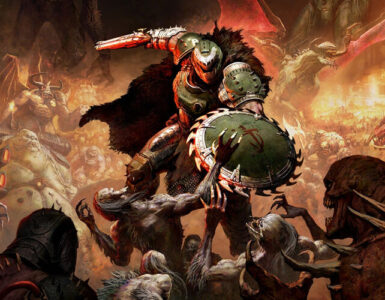Exploring ancient tombs filled with dangerous traps, procuring priceless relics, and barely escaping when everything eventually goes to hell – this theme has become synonymous in the video gaming world with franchises such as Uncharted and Tomb Raider but the man with the hat is back, and he’s showing why if adventure, including in video games, has a name, it has to be Indiana Jones.
Dr. Henry Walton Jones Jr, aka Indy, the key inspiration behind the two aforementioned gaming big-hitters, is finally making his triple-A video game debut with Indiana Jones and the Great Circle. After a lengthy string of past video game entries, which have been largely forgettable movie cash-ins, as well as two decent LEGO spin-offs and of course, the iconic Indiana Jones and the Fate of Atlantis (1992) by LucasArts, it’s up to developer MachineGames and publisher Bethesda Softworks to finally craft an experience worthy of the legendary adventurer.
And while it might be an obvious choice to simply develop an Uncharted clone with an Indiana Jones skin slapped on, MachineGames has utilised its expertise in the first-person-shooter genre from the Wolfenstein franchise reboot, imbuing its signature style into the tried and true tomb-raiding formula. Although this transition to a new perspective goes against the conventions previously set by the genre, the team has managed to pull it off. If you are a fan of the Uncharted series and wish you could experience it from the eyes of Nathan Drake, then this latest Indy adventure will be right up your alley.
Indiana Jones and the Great Circle starts right in the thick of it, literally, putting players in Indy’s shoes as he explores the lush jungles of South America in 1936, exploring a Peruvian temple and eventually coming face-to-face with a giant incoming boulder. Yes, the game starts with a dream sequence mirroring the now-iconic opening scene from the movie that started it all, Raiders of the Lost Ark (1981).

Flashback aside, the game actually takes place in 1937, between the events of the first and third films. When a massive, Latin-speaking stranger breaks into the archaeology wing of Marshell College and steals a cat mummy from one of Indy’s previous expeditions, the famous adventurer must don his fedora and whip and travel the world to investigate the mysterious “Great Circle”, a series of ancient sites arranged to form a perfect circle around the Earth, each housing a strange artefact rumoured to possess world-ending powers.
Of course, Indy isn’t the only one tangled in the mystery. Set two years before the start of the Second World War and during the rise of Nazi power, it’s no surprise that the Third Reich makes a returning appearance as Indy’s main foe, with ambitious plans to acquire the secrets of the Great Circle to obtain global domination, all led by Emmerich Voss, a fellow archaeologist and our hero’s evil counterpart of sorts. Fighting Nazis – if only MachineGames had some expertise in this strangely niche arena with a certain Wolfenstein series as well. Oh, wait…

Without spoiling too much of the game’s plot, what’s on offer here would definitely ring familiar to fans of the original Indiana Jones film trilogy (yes, we said trilogy). From the constant back-and-forth race between Indy and the Nazis to acquire each artefact, to the story slowly deviating from the realm of realism to incorporate supernatural elements, the game pays respects to the classic films that inspired a generation, while simultaneously crafting a standalone story that fits nicely with the series’ well-established timeline.
The game’s story is further complimented by the impressive performance of actor Troy Baker, who does a pretty admirable impression of original Indy actor Harrison Ford’s gravelly vocals, although the facade is hilariously broken at times, leading to him sounding more like Samuel Drake, who he portrayed in Uncharted 4: A Thief’s End (2016). Voss’ voice actor, Marios Gavrilis, also does an exceptional job, presenting a believably intimidating foe and a true rival in terms of intellect.

Just like how the original films filled the hearts and minds of viewers with the thrill of exploring magnificent ancient sites in search of treasure, so too does the game invoke that same sense of wonder, pushing the joys of exploration front and centre in its gameplay experience. As an action-adventure game set mostly in the first-person perspective, players can take in the sights through Indy’s eyes as they explore the game’s various locations, from the majestic halls of Vatican City to the dusty sun-scorched deserts of Gizeh.
Although each area’s main objective usually boils down to accessing its associated Great Circle site in search of artefacts, the game doesn’t play out in a typical linear fashion as seen by the likes of the Uncharted franchise. Instead, the title is split into various open zones, each filled with numerous side activities such as Field Works (side quests) and Mysteries, mini puzzles strewn across the map that revolve around utilising visual clues to unlock a chest for additional loot.

Speaking of loot, the game features a rather unique skill system that cleverly encourages exploration. Over the course of his journey, Indy earns Adventure Points by simply completing missions and puzzles, or by exploring the environment, picking up various notes scattered around the map or taking pictures of interesting sights along the way. In order to use these points, he must then find Adventure Books, which can either be found out in the world or bought at specific vendors with currency acquired while exploring. These provide new skills in exchange for points, ranging from simple health buffs to game-changing abilities affecting both combat and stealth.
With the threat of the Nazis and their allies looming at every turn, Indy needs to use his wits alongside the tools at his disposal to deal with the enemies he comes across. The element of choice when it comes to tackling encounters has always been MachineGame’s strong suit, and here, it’s no different. There are always multiple ways to approach any given situation, be it taking the stealth approach, going in loud and proud, or a mix of the two.

As Indy is just an everyday hero who doesn’t possess any superhuman abilities, stealth might be your best bet to handle encounters, especially in the early game. On the surface, the title’s stealth mechanics follow the tried and true system of sneaking around foes, distracting them by throwing objects or taking them out from behind, although with one major exception – enemies can only be stealthily taken down when Indy is wielding a melee weapon.
This change might seem slight, but it fundamentally changes the way players go about their stealth runs. For example, when faced with two foes having a conversation, you would need to acquire three different melee objects to efficiently dispatch them. One for distracting the first, another to take down the second, and a third to finish off the distracted foe. Every melee item found around the environment, from candles to wrenches and bottles, has its own durability level, and performing a stealth takedown usually breaks them in one go, and this simple change effectively adds a tactical layer to sneaking, although the game does provide new skills later on which allows takedowns without the need for melee weapons.

For some, taking the slow, methodical stealth route might not be appealing, and to this end, the game provides the option to engage in good old fisticuffs with the Nazi scum. Melee combat is simple in its design and largely revolves around timing. Standard punches can be thrown with either your left or right hand, or charged for a power punch that can break through an enemy’s block. To defend against incoming strikes, players can dodge out of the way, or hold a button to block, with precise timing of the block button triggering a parry and opening foes up for a counterattack.
All these actions can be enhanced by picking up items to use as improvised weapons. These deal massive damage and make performing parries easier, but will eventually break after a certain amount of hits. None of these systems are particularly game-changing, and things can get a bit clunky once more enemies enter the fray, but when everything works smoothly, melee combat becomes a satisfying dance, largely owing to its impressive combat animations that feel natural and change depending on the situation.

For instance, counterattacking with the same hand Indy used to parry a strike will cause him to push the foe back, while attacking with the other delivers a quick counterstrike instead. Due to the latter being the more efficient move, players will need to be constantly observant of which hand is used to parry and react accordingly, as every action drains a chunk of Indy’s limited stamina, and depleting it completely mid-fight removes the ability to throw strikes or block until it recharges, which can lead to a quick defeat.
To supplement melee combat, Indy also has access to his trusty whip and revolver, along with firearms that can be picked up mid-combat. A quick crack of his whip towards an enemy will not only disarm them but also stun them briefly, offering a moment of respite or a window to close the gap and strike. Holding down the whip button leads to a whip pull, which grabs enemies and draws them in, or trips them over by targeting their feet, an invaluable tool when faced with multiple opponents.

When all else fails, Indy can throw all discretion out the window and engage in a classic shoot-out. Although this might seem like an interesting prospect, it is in fact the game’s largest flaw combat-wise, due to the extreme lack of ammunition and the overall ineffectiveness of firearms. Guns picked up during fights cannot be reloaded, and enemies are annoyingly bullet-spongy, requiring multiple headshots, even from high-calibre rifle rounds to finally put down. It’s clear that the developers intentionally designed the game with guns being the “last resort”, but it would have been nice if firearms were made a legitimately viable combat option for players to choose if they so desired.
Players can also strategically skip combat or stealth altogether, with the implementation of a disguise system. Every major game area features its own obtainable disguise, and once found, Indy can switch to it on the fly, effectively walking through enemy encampments with them none the wiser. This feature isn’t as overpowered as you might think, as certain high-ranking officers can still see past the disguise, and stealing cash or other valuables while in plain sight will immediately break concealment.

The game might benefit from its solid stealth and combat systems, but where it truly shines is in its tomb-raiding (sorry, Lara Croft). Players will encounter a myriad of ancient sites both optional and along its main story path, like majestic temples, damp underground caves and spooky burial chambers, each presenting its own environmental puzzles and challenges to overcome. While most games in the genre tend to delve into increasingly complex brain teasers requiring copious amounts of trial-and-error, the title excels in its simplicity, offering just the right amount of challenge to not detract from its overall focus on exploration and discovery.
Aside from environmental puzzles, there are also platforming challenges, which are overcome by climbing and swinging with Indy’s whip, gradually draining Indy’s stamina in the process and offering an added bit of urgency. While platforming, the game temporarily shifts to a third-person perspective, and while the constant switching might be jarring at first, the smooth camera transitions and responsive controls make platforming feel consistently gratifying.
In addition to the PC and Xbox consoles, the game is now available on the PS5 too, bringing the added bonus of full DualSense controller support. Its haptic feedback integration does wonders for immersion, adding subtle vibrations to almost every action, including hit and fall impacts or weather effects like rainfall. Adaptive trigger support is included, too, adding varying levels of resistance whether throwing a punch or firing a gun, although this feature cannot be switched off, and considering the many actions in the game requiring a trigger pull, players might understandably become fatigued after prolonged sessions, leaving their only option being to turn adaptive triggers off manually in the PS5’s system settings.

With so much to discover at every turn, it’s fortunate that the game is an absolute stunner too. From the heat waves rippling across the desert horizon, to the lush greenery and subtle fog of the dense Sukhothai jungle, there’s always an opportunity to pause and take in the myriad sights on display. And you’ll be rewarded for doing so too, as the photo-taking minigame encourages capturing snapshots of the game’s more magnificent sights in exchange for extra points, a clear sign that the developers are well aware that they have created something truly special, giving player’s every opportunity to fully bask in its glory.
While both recent Indiana Jones films might not have lived up to the high expectations set by the original trilogy, Indiana Jones and the Great Circle certainly marks a long-awaited return to form for the franchise. If you are even remotely a fan of the Uncharted series or simply want to experience the adventures of Indy played out in real-time, then look no further, because we’ve got a real treasure here, one that doesn’t belong in a museum, but in the hands of all gamers to enjoy.
GEEK REVIEW SCORE
Summary
Indiana Jones and the Great Circle is not just a faithful adaptation of the beloved film franchise, it also stands tall as one of the best action-adventure experiences to date, a firm reminder to its peers of who the original explorer is.
Overall
9/10
-
Gameplay - 8.5/10
8.5/10
-
Story - 8.5/10
8.5/10
-
Presentation - 9.5/10
9.5/10
-
Value - 9/10
9/10
-
Geek Satisfaction - 9.5/10
9.5/10













